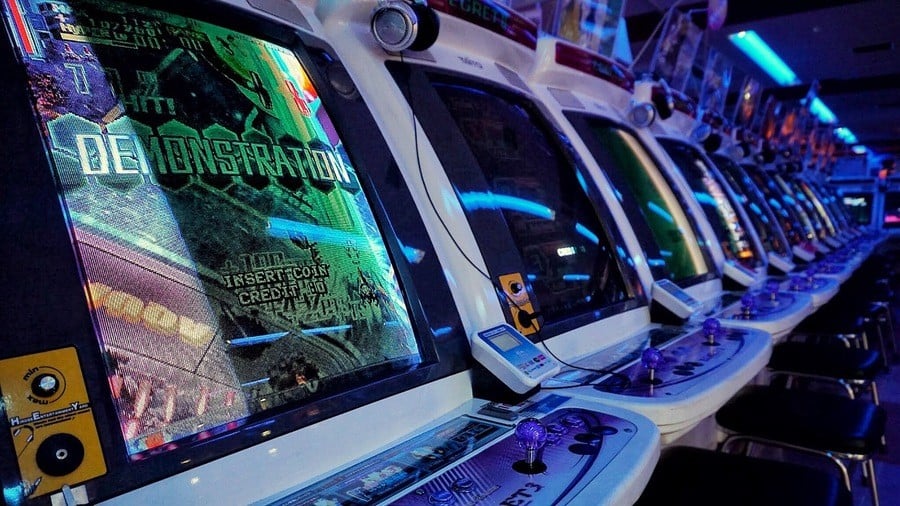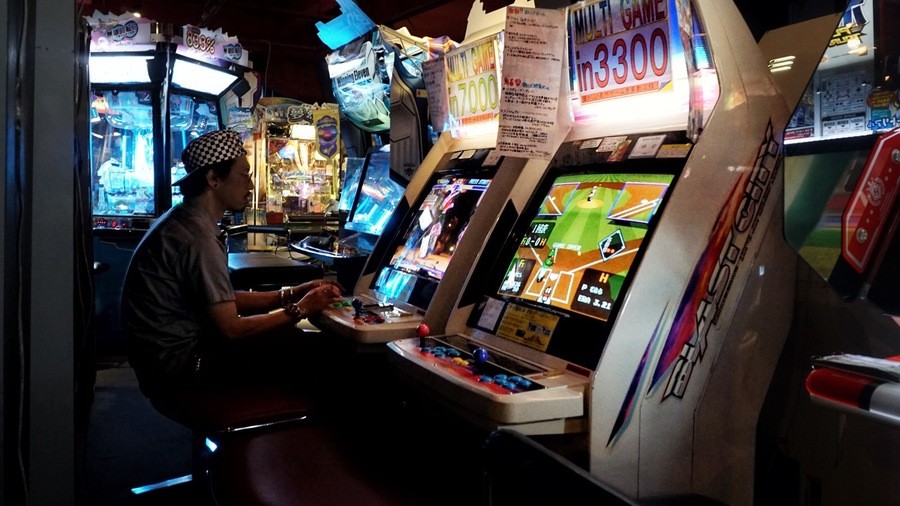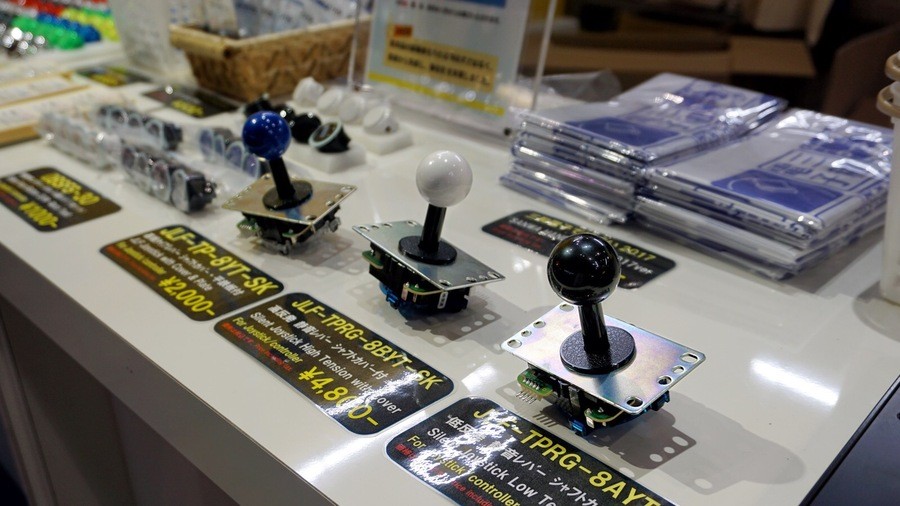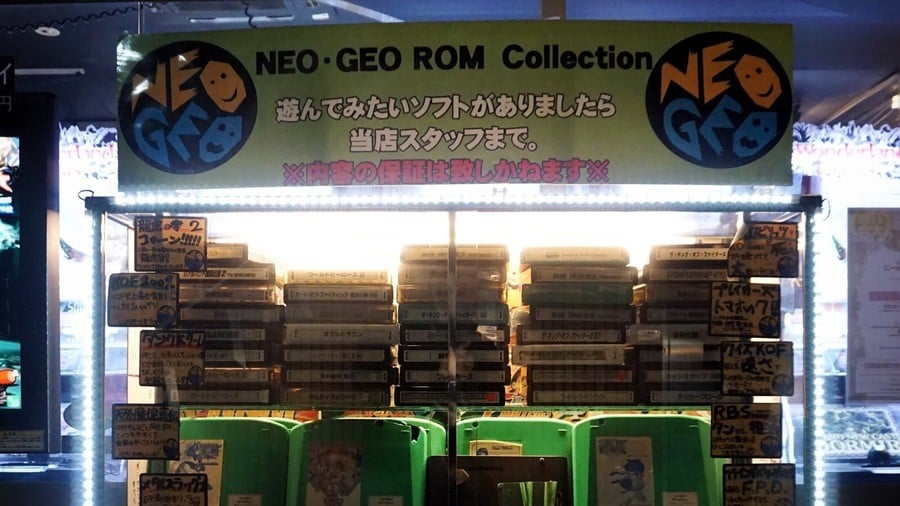
Arcades may have all but died out in the west, but in Japan they remain big business. I write a website about arcades in Tokyo, and sometimes forget it’s not normal to live in an arcade daydream. I‘m prone to using obscure arcade terminology and I neglect readers who don’t click joysticks in the noise so often.
I’m frequently surprised, for example, to be asked what a "candy cabinet" is – which I lazily assumed was common knowledge. I’m sure a lot of you know already, but there’s no shame in rehearsing the basics and no reason not to welcome the arcade-curious to our world. So let’s spell it out.
Candy Cabs 101

A candy cabinet is a standardised arcade cabinet, usually from the '90s, with a screen, control panel and interchangeable games. It sounds a bit like a games console, but unlike a console - which houses the computing hardware and just loads data from a cartridge or a disk to play different games - candy cabinets are more like empty shells, with games coming on circuit boards that actually include the computing hardware. Candy cabs can therefore not only run different games, but also run them on a range of hardware. The candy cab just supplies the screen and controls.
This kind of generic cabinet has never been unique to Japan, but the equivalent cabinets in the West were typically made of wood and intended to be played standing up. Candy cabs are plastic and at a height for sitting down.
The screen can be configured in a standard horizontal setup (in Japanese, yoko) or rotated 90° to a vertical orientation (tate), mainly for vertical scrolling shoot-em-ups, or shmups. The control panel is also replaceable with all manner of button configurations, from a classic stick-and-six to two-player to twin sticks to a 23-button specialist keyboard for the Chinese domino-like game Mah Jong… to just about anything.
Classic Candy

The most popular candy cabs were made by Sega and Taito in the '90s. Taito’s classics are the Egret series. The Egret II (like the older Egret 29) has a mechanism enabling the monitor to be rotated from yoko to tate simply, by one person. On other cabs, that change means recruiting a friend to heave a massive old TV out and back in again. The Egret II is therefore a favourite for personal games rooms, where you might only have one cabinet and want to switch between vertical and horizontal games. Taito’s famous Hey arcade in nerdopolis Akihabara has iconic long rows of Egrets flying off into the distance under dim blue lights.
Sega’s candy cabs are mostly some kind of "City": Astro City, Blast City, Net City… A cabinet I find particularly fun in its commitment to a single cause is the Sega Versus City, launched in 1996. Versus Cities are enormous things with two screens and control panels back-to-back, like conjoined candy cab twins, bonded by their capacious plastic skin and sharing their internal circuit board organs. They’re built for two-player competitive play, usually on fighting games. The idea is that players can’t react to what they see – or even hear, believe it or not – their opponent doing with their stick and buttons. With the Versus City, players can react only to what is on the screen.
Candy Cabs Today

Games are still made for candy cabs, especially relatively niche-interest shmups and fighters. Modern generic cabs are still sold by Sega and Taito and are in most Tokyo arcades, but the candy cabs of the '90s remain a commonplace symbol of retro-hardcore gaming, and are also sought after by players and collectors for home arcades and museums.
Even more sought-after are the PCBs – the printed circuit boards hosting the games. Although serious candy-heads may prefer to change out the boards through the lockable service doors on the front of the machines, there is a modern-day alternative: emulation. Emulating old games on standard hardware like a PC or console stashed inside the cabinet enables players to select from multiple games before dropping their coins.
Emulation is a handy approach for the home arcade, but it’s also present in Tokyo game centres. Actual PCBs introduce maintenance challenges for a big arcade, particularly for ageing games, and swapping them is a hassle, so emulation is sometimes the pragmatic way to go. An emulator cabinet might still only offer a single game, though, and some PCBs actually present a choice from dozens, so you may not know whether you’re playing an emulator cab. But if the machinetop advertises a choice of ten thousand games (yes, those exist), it rather gives the game away.
Unless you’re a very serious arcade gamer who can tell the difference by playing (which I’m not), your best way to be sure you’re playing a real PCB – if you care about doing that – is to go to an arcade like Club Sega in Nishishinjuku, where staff will install an old '90s board from a display case at your request.
Most recent candy cabinet games – like the newest King of Fighters or BlazBlue (both fighting games) – are downloaded from the internet onto a standard board installed in the machine, streamlining candy cab operation for the modern world. This approach frustrates some home collectors who can’t access the download service outside Japan, but it’s an encouraging sign that these cabinets will keep on going.
Sticking Power

The cabs change and the games change, but the sticks and buttons have been relatively constant. The two biggest names are Sanwa and Seimitsu, both of which are very much dad-aged, having been making joysticks since the '80s. Sanwa had a booth at the Tokyo Game Show in 2017 selling their latest products, which included "silent" controls to help keep your combos private.
The constancy of stick and buttons over the years gives arcade gaming a traditional feel, even in its most modern incarnations. There’s a timelessness about candy cab gaming – which is all the more apparent if you consider that many big games were born before their players.
Suck it and See

If you want to taste the candy cab experience in Tokyo, you can find them in plenty of arcades, including the big-name Segas and Taitos. Look out for yellowed plastic, bulging 4-to-3- (i.e. old-TV-) ratio screens, and colourful buttons. A helpful little rule of thumb for the newbie hunter: the candy’s in the basement.
Finally, the question I’ve ignored all the way through: why are they called candy cabs? Because the bright, multicoloured joysticks and buttons look like sweets! Or so the story goes. You can certainly picture a dayglo-dressed '90s teen popping plastic-green gumballs while they brawl their way through a pixelated Neo Tokyo. But the real answer is probably that the first Japanese cabinets to be exported west in a big way were SNK’s, with model names like “Candy 18” and “Candy 25”. But that’s dull – let’s say it’s the gumballs. Why not head to Tokyo one day and taste the retro sweetness for yourself?
Thanks go to Chun Wah Kong (@chunwahkong on Instragram) and Aaron Kraten (@akraten on Instagram) for fact-checking and explanations that helped make this article!





Comments 44
I was in Japan in 2016 and I have to say I had a hard time finding retro games in arcade centers. It was very disappointing to me when I entered several Sega centers and all cabinets there were modern and for modern games. No retro whatsoever.
I had the chance to visit a hidden candy cabinet place in Hiroshima, but just because a friend of mine had told me about it. And I was afraid of touching, because some cabinets had a sign asking visitors not to touch them and only a handful were playable. I tried Vs. Super Mario Bros for a few minutes, I really had no time and had to be somewhere else. Old arcades are hard to find, although exist, and you must be searching for a specific place in order to find it. You won't find them on crowded tourist-oriented places.
There is also one on the top floor of Mr. Potato, the super expensive tourist trap game shop in Tokyo. Candy cabs too.
Everytime I go to Japan(4 times in the last 10 years) some arcades are closed or the video game cabinets are replaced with UFO catchers(crane games).
Still, Japan remains one big playground for adults.
I need to stop finding excuses NOT to have one of these at my home's entrance hall. Adulting sucks!
@BigKing Yes, all UFO catchers, a total shame
Have never experienced playing on a true arcade cabinet. But someday I will. And someday I'll go to Japan for myself.
As a JAMMA cab owner, my love for original hardware shows. Sure I could get a MAME cab but original hardware is the authentic way to go.
As in the article, here in Europe they were all big, upright wooden affairs with my personal cab being from the 80s, way before they changed to the white, plastic deals that exist now. I love the customisation afforded to a legit cab. The swappable PCBs, the authentic experience and how individual you can make the parts.
I've got several different sticks with varying button/stick types/colours/manufacturer, some of which I made for specific games etc. Usually I try not to go overboard (not point having 4 different 6 button sticks for kick harness stuff) but sometimes you gotta do what you gotta do.
It's a shame it all died off because it's an experience that can't be replicated by anything short of getting one yourself. The amount of fun I've had around my cab by myself or with friends is leagues ahead of anything else we can play on. Not to mention the old memories in arcades with everyone watching, beating games, being really good at games, winning streaks on beat'em'ups...
I most likely will get a MAME cab eventually because there is no denying the ease of use and convenience for "let's quickly play some X game" and the price of finding some of the better, working PCBs.
Arcade cabs are a superior experience for many games overall, but the cost, size and space requirements can be prohibitive. Just like finding and getting cabs/games. In a perfect world I'd have many cabs, some dedicated to 1 game, some swappable for all the major platforms, (JAMMA, CPS-3, Neo Geo, whatever SEGA used). One thing at a time....
Retro gaming for life.
Thanks for the article! Brings back so fond many memories of the 90s How I missi those massive arcade CRTs and scanlines... A pitty that here arcades are long dead.
My secret wish is to have one of these at home but with the wife in the equation that won't ever happen :/
Really enjoyable article. Thanks. I'd love a candy cabinet at home.
Great article and I just have Chun Wah Kong and Aaron Kraten a follow on Instagram!
A neat, informative article! The closest thing I've played to one of these was a MAME cabinet that an instructor at my college built. I unfortunately missed out on the arcade scene (I missed the 80s entirely and grew up in a rural area), though I've heard a nearby town had a decent arcade at one point. You used to be able to find arcade machines at most eateries around here, but those are becoming more scarce and have for the most part been replaced by lousy crane machines. It's getting harder to find my beloved pinball cabinets....
One day I'll be able to Go to Japan and visit these hallowed halls. One day.
@Moroboshi876 I sometimes see some of these small places in Japan posted/retweeted on twitter by Yosuke Okunari (okunari on twitter). Sometimes it's like looking into the past. I'd like to see some of these hidden game rooms for myself when I finally make it to Japan.
I'm at least glad I got to experience cabinets like Tron, Discs of Tron (the "environmental" version) or Satan's Hollow during their prime in the 80's. Half the game was the design of the cabinet.
I miss arcades. The only places nearest to me where they have them are some bar/restaurant called Dave's, and our local Chuck E. Cheese.
@NintendoFan4Lyf Sorry! xD
I have a love hate relationship with candy cabs. They make things easier to update, but I love the old art on the cabinets. Im currently restoring an old Atari Centipede and its gonna look pretty damn gorgeous when its done.
The Taito Hey in Akihabara is essential for anyone looking for retro arcade games. Genres are divided by its six floors, with the older stuff higher up. It's also the only place I know of to play the original Densha de Go. It's as hard as everyone says it is.
Fantastic article....I love these little snapshots into the "natural environment" culture Japan still has in their old buildings as we've sanitized all of ours into synthetic perfection. All our entertainment space looks like a Japanese corporation than the actual places of living in Japan.
@Matthewxcv "Have never experienced playing on a true arcade cabinet. But someday I will. And someday I'll go to Japan for myself"
On one hand that makes me feel so old. On the other hand, I've still got a nice Japanese-owned arcade near me....brand spanking new, and a small retro section. It's all new candy cabs (and modern machines) though, no actual collectors equipment (as it should be for an actually profitable operational arcade!)
@BigKing @Moroboshi876 Hehe – when I wrote about Tokyo and asked “is the arcade scene really dying?” folks came out to say it’s thriving. Now I write about candy cabs thriving, people say it’s all dying away!
Everyone’s right, of course – places do close and the types of game/attraction that pull in the money are changing, so those do eventually win some more floor space. True as well that retro games are getting sparse in Sega arcades. I visited 20 Tokyo Sega centres in one day and was surprised at how many had no candy cabs at all – but the big locations (Shinjuku, Ikebukuro) had a good bunch and a tournament scene too.
The evergreen tip for retro gaming in Tokyo remains: Go to Hey. As the pictures show, there are plenty of candy cabs to be found (and I mentioned the arcades in all the captions in case you want to go)!
Thanks for reading and for the comments
@Menchi187 I don’t have a cab myself but I bet it’s a brilliant hobby to collect and tinker with this stuff. I would say that candy cabs have not died out in Tokyo. They’re certainly not the main way to game in the arcades, but they are alive and well, both with retro games and hardware and with modern networked PCBs.
And I seriously cannot see Super Street Fighter II Turbo ever disappearing as a competitive event!
If I’m trying to doom-monger I’ll say CRTs will disappear before we’d like, but we’ll hopefully have better tech to emulate that classic viewing experience by then (≥4K, HDR…)
Thanks for reading!
@tangram Thanks for the comment – it was a pleasure to write the article because commenters here are always so nice! I can relate to every part of your comment – except that I will not give up hope!
@samuelvictor I also love those Sega cabs. Probably an Astro City would be the dream for me…
Someone I follow on Instagram got one recently in the UK. They had help from another arcade nerd on IG, who pointed them at someone they knew from a forum… There seems to be a really nice community around it if you start asking!
@Lroy Thank you! Yes, so would I…
As much as I like gaming and old arcade cabinets, I hate going to game centers in Japan. It’s one of the few first world countries that still allows smoking indoors. You’ll find old men sitting at candy cabinets holding a lit drag while playing. I often see schoolchildren wandering around with people smoking in front of them. It’s atrocious.
@wasilewski Thank you – and they are great guys with great Instagram accounts so I’m sure you’ll be glad you followed them! You can also follow me @arcade.tokyo, you know
@CorruptPhoenix Yep, this is the one thing that always comes up! It’s pretty gross, but not as infuriating as in a restaurant or cafe. It would be much better if smoking wasn’t allowed, but I guiltily tell myself it’s part of the atmosphere and sometimes revel in it.
I would say I don’t think it’s common to see young kids walking around in a smokey environment. There are non-smoking floors and sections which are typically the ones the kids will play. It does get problematic with teens and young adults, who do overlap on the big-name franchises. I wonder how long it can last in the modern world…
@Tyranexx Thank you! Remember the arcade scene is still going in Tokyo, so you haven’t missed it completely!
@masterLEON Okunari: great tip, thank you!
@Arcade_Tokyo Thanks for writing~
When I said dying out I meant here in Europe. It's all video poker and video slots here. I only know of 2 arcades here in Ireland, 1 is a barcade which has about 2 dozen old school legit cabs and the other used to be a huge arcade but now is 95% slots/poker and only a handful of decade+ old actual games stuck in a back corner
@Iacobus @celestian1998 Japanese arcades these days are actually mostly custom cabinets with mad art and very serious hardware (trading card readers, sit-ins, custom sticks, buttons, mice…) – but it has moved away from the style and atmosphere of the classics from back in the day, it’s true…
@Menchi187 yeah it’s very different in Japan. I wish I could say it’s just like the good old days, but the most popular games are convoluted trading card / online / free-to-play franchises that are pretty inaccessible to visitors. It’s still brilliant but it’s just different.
@TheOpponent lol yes I love that old Densha de GO! And right behind it Darius and The Ninja Warriors. Good old Hey
@NEStalgia Thank you! If you love the little snapshots then take a look at my site and let me know what you think – and I have a weekly newsletter too!
@Arcade_Tokyo How do you pay for the games in a Japanese arcade?
Unfortunately, arcades were never popular here, not even in the 80s and 90s so my experience is limited to Italian arcades in the late 90s where you had to buy special tokens.
My only visit to a modern arcade was Dave and Busters in New York City. There you have to buy a card that you load up with money.
@countzero You can see in the top picture a small device below the screen, which is a card reader. There are a few different cards that you load with credit and tap to pay. You can also use standard e-money cards used on public transport and smartphones too. Those readers are fitted even to these old candy cabs.
The best thing is, though, that almost all cabs old and new still accept ¥100 coins, which of course is the best way to play!
Would have loved to see an Italian arcade! I lived in Milan for 2 years but never found one…
@Arcade_Tokyo: Good point! Now if I can actually make it to Tokyo....
@Arcade_Tokyo Cool, that's convenient!
I think in Italy I have only seen arcades in places with a lot of tourists.
@Arcade_Tokyo thanks again, and I followed your Instagram too. 👍
Someone should make a Taito Egret II case for the Switch, it would be glorious to play Strikers 1945 I&II, Gunbird, Samurai Aces, Dragon Blaze, Gunbarich and soon Ikaruga and Psyvariar on it.
@EmirParkreiner That would be cool! Although personally I would prefer a Sega cab
@Arcade_Tokyo Ohh, fantastic pics on that front page! I'll have to look more later! I just love how Japan has this very "real" underbelly behind the glossy falseness. Over here, we just adopted glossy falseness for everything and wiped away the reality behind it. Strange that Japan is the place more obsessed with uniformity, yet still retains a bit more reality.
@NEStalgia It’s certainly a place full of paradoxes if you want to chat about Japanese arcades then find me on Instagram or Twitter – or get the email newsletter from arcade.tokyo/weekly – feedback always welcome!
If you're looking for candy cabs in the UK you should check out Konbo in Edinburgh: www.konbo.co.uk It's a Japanese arcade cafe with Astro City & Blast City cabs, original game PCBs, plus vintage Japanese arcade art.
@MikeHaggar been following those guys (you guys? ) on Instagram for ages and hope to visit one day!
The term candy cab is actually a big mistake by westerners. The “mass” first batch of guys in the west imported these were predominantly NeoGeo collectors. So they of course went for NeoGeo cabinets. SNK actually made a model properly named “Candy” and these guys imported these Candy cabinets. As they posted about them in the forums folks who had never seen them called them Candy Cabs and the name stuck as a way to refer to all Japanese arcade machines. Much like your Mom called every video game console a Nintendo or SEGA. Completely understandable how the term came to be, but still feels so Joe Sixpack haha. First time I encountered these beautiful machines were in the 80’s on trips with my grandmother and later again in the 90’s with my parents. Lots of evolution in styling between those two decades. When I saw “modern” styled machines for the first time in the early 90’s, I swore I would own some one day... fast forward to 2000 and I was able to get my first batches of machines
Show Comments
Leave A Comment
Hold on there, you need to login to post a comment...